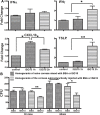ISG15 Acts as a Mediator of Innate Immune Response to Pseudomonas aeruginosa Infection in C57BL/6J Mouse Corneas
- PMID: 32416603
- PMCID: PMC7405721
- DOI: 10.1167/iovs.61.5.26
ISG15 Acts as a Mediator of Innate Immune Response to Pseudomonas aeruginosa Infection in C57BL/6J Mouse Corneas
Abstract
Purpose: IFN-stimulated gene (ISG) 15 is a type 1 IFN-induced protein and known to modify target proteins in a manner similar to ubiquitylation (protein conjugation by ISG15 is termed ISGylation). We sought to determine the role of ISG15 and its underlying mechanisms in corneal innate immune defense against Pseudomonas aeruginosa keratitis.
Methods: ISG15 expression in cultured human corneal epithelial cells (HCECs) and mouse corneas was determined by PCR and Western blot analysis. Gene knockout mice were used to define the role of ISG15 signaling in controlling the severity of P. aeruginosa keratitis, which was assessed with photographing, clinical scoring, bacterial counting, myeloperoxidase assay, and quantitative PCR determination of cytokine expression. Integrin LFA-1 inhibitor was used to assess its involvement of ISG15 signaling in P. aeruginosa-infected corneas.
Results: Heat-killed P. aeruginosa induced ISG15 expression in cultured HCECs and accumulation in the conditioned media. Isg15 deficiency accelerated keratitis progress, suppressed IFNγ and CXCL10, and promoted IL-1β while exhibiting no effects on IFNα expression. Moreover, exogenous ISG15 protected the corneas of wild-type mice from P. aeruginosa infection while markedly reducing the severity of P. aeruginosa keratitis in type 1 IFN-receptor knockout mice. Exogenous ISG15 increased bacteriostatic activity of B6 mouse corneal homogenates, and inhibition of LFA-1 exacerbated the severity of and abolished protective effects of ISG15 on P. aeruginosa keratitis.
Conclusions: Type 1 INF-induced ISG15 regulates the innate immune response and greatly reduces the susceptibility of B6 mouse corneas to P. aeruginosa infection in an LFA-1-dependent manner.
Conflict of interest statement
Disclosure:
Figures







Similar articles
-
Interferon regulatory factor-1 in flagellin-induced reprogramming: potential protective role of CXCL10 in cornea innate defense against Pseudomonas aeruginosa infection.Invest Ophthalmol Vis Sci. 2013 Nov 15;54(12):7510-21. doi: 10.1167/iovs.13-12453. Invest Ophthalmol Vis Sci. 2013. PMID: 24130180 Free PMC article.
-
ISG15 in Host Defense Against Candida albicans Infection in a Mouse Model of Fungal Keratitis.Invest Ophthalmol Vis Sci. 2017 Jun 1;58(7):2948-2958. doi: 10.1167/iovs.17-21476. Invest Ophthalmol Vis Sci. 2017. PMID: 28599020 Free PMC article.
-
TSLP Protects Corneas From Pseudomonas aeruginosa Infection by Regulating Dendritic Cells and IL-23-IL-17 Pathway.Invest Ophthalmol Vis Sci. 2018 Aug 1;59(10):4228-4237. doi: 10.1167/iovs.18-24672. Invest Ophthalmol Vis Sci. 2018. PMID: 30128494 Free PMC article.
-
Corneal response to Pseudomonas aeruginosa infection.Prog Retin Eye Res. 2004 Jan;23(1):1-30. doi: 10.1016/j.preteyeres.2003.10.002. Prog Retin Eye Res. 2004. PMID: 14766315 Review.
-
ISG15 and immune diseases.Biochim Biophys Acta. 2010 May;1802(5):485-96. doi: 10.1016/j.bbadis.2010.02.006. Epub 2010 Feb 12. Biochim Biophys Acta. 2010. PMID: 20153823 Free PMC article. Review.
Cited by
-
Tannin coordinated nanozyme composite-based hybrid hydrogel eye drops for prophylactic treatment of multidrug-resistant Pseudomonas aeruginosa keratitis.J Nanobiotechnology. 2022 Oct 14;20(1):445. doi: 10.1186/s12951-022-01653-w. J Nanobiotechnology. 2022. PMID: 36242070 Free PMC article.
-
Transcriptome Analysis Reveals Possible Immunomodulatory Activity Mechanism of Chlorella sp. Exopolysaccharides on RAW264.7 Macrophages.Mar Drugs. 2021 Apr 14;19(4):217. doi: 10.3390/md19040217. Mar Drugs. 2021. PMID: 33919822 Free PMC article.
-
Proteomics Mapping of the ISGylation Landscape in Innate Immunity.Front Immunol. 2021 Aug 10;12:720765. doi: 10.3389/fimmu.2021.720765. eCollection 2021. Front Immunol. 2021. PMID: 34447387 Free PMC article. Review.
-
Functional and Transcriptional Adaptations of Blood Monocytes Recruited to the Cystic Fibrosis Airway Microenvironment In Vitro.Int J Mol Sci. 2021 Mar 3;22(5):2530. doi: 10.3390/ijms22052530. Int J Mol Sci. 2021. PMID: 33802410 Free PMC article.
-
Single-cell transcriptomic landscape of the sheep rumen provides insights into physiological programming development and adaptation of digestive strategies.Zool Res. 2022 Jul 18;43(4):634-647. doi: 10.24272/j.issn.2095-8137.2022.086. Zool Res. 2022. PMID: 35838034 Free PMC article.
References
-
- Cruciani F, Cuozzo G, Di Pillo S, Cavallaro M. Predisposing factors, clinical and microbiological aspects of bacterial keratitis: a clinical study. Clin Ter. 2009; 160: 207–210. - PubMed
-
- Zhang J, Xu K, Ambati B, Yu FS. Toll-like receptor 5-mediated corneal epithelial inflammatory responses to Pseudomonas aeruginosa flagellin. Invest Ophthalmol Vis Sci. 2003; 44: 4247–4254. - PubMed
Publication types
MeSH terms
Substances
Grants and funding
LinkOut - more resources
Full Text Sources
Molecular Biology Databases
Research Materials
Miscellaneous

